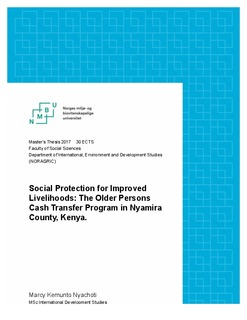| dc.description.abstract | Well-designed and properly implemented social protection programs, through cash transfers have the potential to lift people out of poverty. In the short term they enable the beneficiaries to purchase basic consumables such as food and clothing. In the medium term they give the poor an opportunity to choose how to use the transfers in productive ways that will increase their production and income levels. In the long-term, they have the potential to create a healthier, more productive and educated generations, thus expanding on the human capital base and helping break inter-generational poverty. These impacts constitute the underlying rationale cash transfer programs in the social protection paradigm.
The older persons cash transfer program (OPCTP) in Nyamira County started in the year 2013 as a pilot project with 10 households receiving KES 1,000 ($10) per month. Since then, the program has scaled up and now has 1,799 beneficiaries each receiving KES 2,000 ($20) per month. The OPCTP targets old people aged over 65 years and who are extremely poor. Targeting only the extremely poor among the old is a challenge prone to high exclusion errors as a result of high poverty head count and the constrained government budget. However, those enrolled in the program are expected to use the transfers in ways that will have immediate impact on their household expenditure as well as long-term effects on human capital and asset accumulation.
This study uses qualitative methods, to assess perceptions on targeting criteria, selection procedures and cash delivery systems adopted by the OPCTP in Nyamira County. It also looks at the impacts of the program on improving the livelihoods of the beneficiaries. The livelihood changes looked at are, food consumption, education and productive asset acquisition. The cash transfer program has adopted 3 targeting mechanisms to identify the beneficiaries of the program, however it is still faced with high exclusion errors. The selection of beneficiaries is almost entirely dependent on the community members, and this has brought forth other challenges such as tension between beneficiaries, non-beneficiaries and the local community representatives. This has resulted in weakening social cohesion among community members.
In retrospect, the program has positively transformed the lives of the beneficiaries with indicators showing improved housing, purchase of productive assets, access to more and better meals and increased school attendance. Women beneficiaries have especially proved to engage more in productive asset acquisition and subsistence farming that has helped them stabilize the households’ consumption patterns. Through the income they get from both the transfers and productive investments, the women are able to support their dependents, especially the grandchildren’s education and feed them better. Therefore, transfers especially when directed to women not only improve the life of the beneficiaries but also those of the grandchildren. Giving cash transfers to the vulnerable can help them preserve, build and increase their asset base. In the long term such impacts will reduce the vulnerability and risk exposure of the extremely poor and help build an educated and healthier generation. These efforts will help in breaking inter generational poverty giving the children from poor households an opportunity for better life in the future. | nb_NO |

